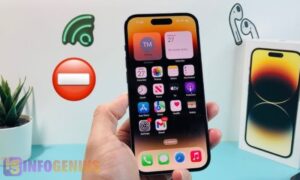Wondering how to tell if someone blocked you on iPhone? It’s a common question in today’s connected world, where communication breakdowns can leave you uncertain. Apple’s blocking feature is designed to maintain privacy, but it doesn’t provide clear notifications to the blocked person.
This guide will help you uncover the subtle signs of being blocked, test your suspicions without crossing boundaries, and handle the situation with respect. By understanding these steps, you can navigate this delicate situation with confidence and clarity.
What Does Blocking Do on iPhone?
When someone blocks you on their iPhone, all direct communication methods are disrupted. Whether you call, text, or try FaceTime, your attempts will fail or go unnoticed by the other person. However, Apple ensures that the process is discreet, and you won’t receive any notification about being blocked.
Knowing how to tell if someone blocked you on iPhone involves recognizing subtle changes in your interaction with the individual. Calls may not go through, messages might appear undelivered, and even shared services like Find My could be affected.
Signs That Indicate You’ve Been Blocked
Calls Going Straight to Voicemail
One of the most obvious signs is when your calls go straight to voicemail without ringing. This doesn’t always confirm a block—factors like airplane mode or a dead battery could also cause it—but repeated occurrences are a strong clue.
Messages Not Marked as Delivered
On iPhones, iMessages display a “Delivered” status once they reach the recipient. If you notice that your messages are consistently missing this tag, it’s a sign that you might have been blocked.
FaceTime Calls Failing Instantly
FaceTime provides another way to check. If your calls fail to connect or drop instantly, it’s possible the recipient has blocked you. This happens because blocked numbers can’t initiate FaceTime communication.
Lack of Engagement on Shared Apps
If you’re accustomed to seeing updates from the person on shared Apple services, like Find My, and they suddenly disappear, this could indicate that you’ve been blocked.
How to Tell If Someone Blocked You on iPhone: Testing the Signs
Make a Call from Another Number
The easiest way to test is by calling the person from a different number. If the call connects, but your original number still goes straight to voicemail, you’ve likely been blocked.
Send a Message and Observe
Send an iMessage and check for the “Delivered” or “Read” tag. If it doesn’t appear over several attempts, it’s a strong indicator of a block. Make sure the recipient hasn’t switched to SMS, as this could also affect delivery status.
Use FaceTime for Confirmation
FaceTime calls that fail immediately are another sign of being blocked. If you can successfully connect using another account, the likelihood of a block increases.
Check for Social Media Activity
If you’re blocked on iPhone, you might still be able to observe the person’s activity on social media. A sudden lack of interaction there could further support your suspicions.
What Blocking Looks Like for the Blocker
Blocking on iPhones is straightforward and ensures the blocker experiences no disruptions:
Calls from blocked numbers are redirected to voicemail without notifications.
iMessages appear sent but don’t notify the recipient.
FaceTime calls fail silently.
Notifications from the blocked contact are completely suppressed.
By learning how to tell if someone blocked you on iPhone, you’ll realize that the experience for the blocked individual is more about subtle clues rather than explicit signs.
Common Misconceptions About Being Blocked
Airplane Mode Mimicking Blocking
Sometimes, airplane mode or network issues can cause similar behavior to being blocked. Ensure you consider technical reasons before assuming you’ve been blocked.
Muting vs. Blocking
Being muted isn’t the same as being blocked. Muting silences notifications but doesn’t restrict messages or calls from going through.
Temporary Blocks
It’s possible for someone to temporarily block you and then unblock you later. In this case, the symptoms of blocking may appear inconsistently.
Tips for Handling the Situation Gracefully
Respect Boundaries
If you suspect you’ve been blocked, avoid repeatedly trying to contact the person. Respect their decision and give them space to address the situation on their terms.
Use Other Channels for Communication
If it’s important to reach the person, consider using mutual friends or alternative communication platforms to clarify the situation. Be polite and avoid confrontation.
Reflect on the Relationship
Take time to assess why you might have been blocked. Whether it’s a misunderstanding or a fallout, use this opportunity to reflect on how to improve your relationships.
Tools and Apps to Support Your Efforts
Third-Party Apps
Apps like Truecaller can offer insights into whether your number has been blocked. However, they don’t directly confirm a block on iPhone.
Social Media Platforms
Platforms like WhatsApp or Facebook Messenger can provide additional clues. If you’re able to contact the person there but not via iPhone, it’s likely a block on their Apple device.
Online Forums for Support
Tech forums and communities can be a helpful resource for understanding and troubleshooting potential blocking scenarios.
FAQs
Q1: Can I confirm if someone blocked me on iPhone?
No, Apple doesn’t notify blocked individuals, but observing repeated signs like undelivered messages and failed calls can provide strong indications.
Q2: Does being blocked affect group chats?
No, blocking doesn’t remove you from group messages. You can still interact within shared groups.
Q3: Can I leave a voicemail if I’m blocked?
Yes, but the recipient won’t receive a notification about the voicemail.
Q4: Will messages sent during a block be delivered later?
No, messages sent while blocked won’t be delivered, even if the person unblocks you later.
Q5: Can I test being blocked using FaceTime?
Yes, if FaceTime calls repeatedly fail, it’s a sign that you might have been blocked.
Conclusion
Understanding how to tell if someone blocked you on iPhone involves careful observation and respectful action. While signs like undelivered messages, failed calls, and restricted FaceTime communication suggest a block, it’s crucial to consider technical factors and avoid jumping to conclusions.
Respect privacy, reflect on your interactions, and focus on resolving misunderstandings maturely. Whether the block is temporary or permanent, handling it with grace will help maintain your personal dignity and relationships.








